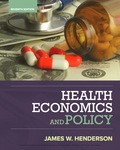How do you draw a health production function with individuals receiving some health producing intervention as inputs and health benefits as outputs that shows declining returns in output. What does “declining returns” imply about the marginal health benefit per person served/treated along this production function? How does this relate to “specialization of inputs”? How about “selection to treatment”? If we assume that you have two distinct means of producing health (programs A & B) with identical PFs as you drew above. Given a fixed amount of inputs (e.g. ability to treat/serve some number of individuals), draw the production possibilities frontier curve for these two programs. What is an opportunity cost and how does it relate to the PPF curve? If our value the health benefits from both programs equally, what point (label as X) do you pick on the PPF curve and why? Suppose program A works best for children, and program B best for adults, and you value health benefits (outputs) provided to children more than adults, what point (roughly, label as Y) would you pick on the PP curve and why? Are either one of these points more or less economically efficient than the other (or not)? What would a graph showing how demand for medical care changes under health insurance where the insurance policy pays a % of costs look like. What happens to demand elasticity? Amount purchased at any price? What does this say about the effect of health insurance on individual vs. social “perceptions” of health care cost and benefit? Suppose you have two persons, one with more elastic demand for medical care than the other. If they both obtain identical health insurance coverage (or both have their % of costs paid by insurance increased), whose demand will be affected most? Given what you know about relative demand for MC for well vs. ill individuals, more educated vs. less educated persons, and wealthy vs. less wealthy individuals, which of each pair will have the greatest increase in demand under health insurance? Show how a consumer would choose between medical care and health(y) behavior activities using the graphical representation of the consumer choice model (assume that “amounts” of healthy behavior have “costs” or prices). How might health education affect this choice? What if medical care becomes more productive (more health benefit per “unit” of medical care consumed)? What if medical care becomes cheaper? Explain in terms of the model (i.e. what does it change in the model).
How do you draw a health production function with individuals receiving some health producing intervention as inputs and health benefits as outputs that shows declining returns in output. What does “declining returns” imply about the marginal health benefit per person served/treated along this production function? How does this relate to “specialization of inputs”? How about “selection to treatment”?
If we assume that you have two distinct means of producing health (programs A & B) with identical PFs as you drew above. Given a fixed amount of inputs (e.g. ability to treat/serve some number of individuals), draw the production possibilities frontier curve for these two programs. What is an
If our value the health benefits from both programs equally, what point (label as X) do you pick on the PPF curve and why? Suppose program A works best for children, and program B best for adults, and you value health benefits (outputs) provided to children more than adults, what point (roughly, label as Y) would you pick on the PP curve and why? Are either one of these points more or less economically efficient than the other (or not)?
What would a graph showing how
Suppose you have two persons, one with more
Show how a consumer would choose between medical care and health(y) behavior activities using the graphical representation of the consumer choice model (assume that “amounts” of healthy behavior have “costs” or prices). How might health education affect this choice? What if medical care becomes more productive (more health benefit per “unit” of medical care consumed)? What if medical care becomes cheaper? Explain in terms of the model (i.e. what does it change in the model).
Step by step
Solved in 2 steps









